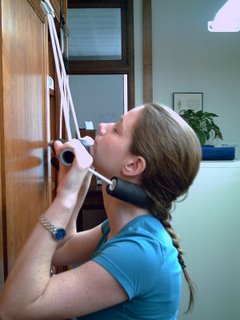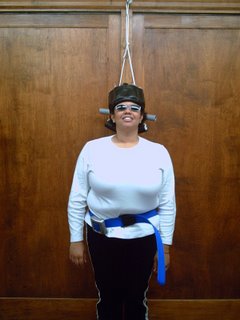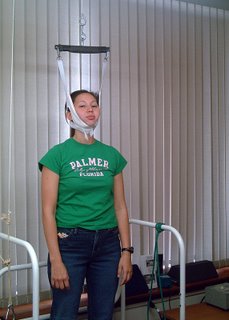Fixing our spines!
 Kristin performs cervical traction to rehydrate the discs in her cervical spine and help to restore lordotic curve to her neck.
Kristin performs cervical traction to rehydrate the discs in her cervical spine and help to restore lordotic curve to her neck.Kristin, DeJeanne, & I have been super busy learning so much about spinal rehab and actually going through the protocol to correct each of our individual spinal issues. After yesterday's sessions, we all felt the best we've felt in a very long time. DeJeanne gets set up for a base vertex film.
DeJeanne gets set up for a base vertex film.
 DeJeanne gets set up for a base vertex film.
DeJeanne gets set up for a base vertex film.- DeJeanne's scoliosis has worsened since 2004. Her Cobb angles measured 32 degrees in the mid-thoracics, and 65 degrees in the lumbars. Per yesterday's films, her Cobb angles are 62 degrees at T9 and 70 degrees at L1. Her spine is in an active state, meaning her scoliosis will only get worse and continue to compress and wind-up like a corkscrew, called the "crankshaft effect".
- Kristin has right alar ligament damage on her axis from car accidents (and roller coasters) as well as forward-rolled shoulders that contribute to extreme forward head posture and 238% of loss of lordotic curvature of her cervical spine (she has a reverse curve in her neck).
- I have a retrolisthesis of L5 on the sacrum, lateral curvature in my thoracics, as well as 65% loss of curve in my cervical spine thanks to some serious ligament damage.
At the end of the week, I'll post our pre and post care films to show the dramatic difference 5 days of intense chiropractic care and rehab can do to make scoliosis less severe and structural problems in a non-scoliotic spine less impacting. Our home care protocols consist of head-weights, cervical traction, and specific rehab exercises for muscle strengthening based on our individual film findings. We're faithful to complete our rehab each morning and evening as well as the intense program at the clinic.  Kristin & I wobble to warm up our spines form T7 down to pelvis.
Kristin & I wobble to warm up our spines form T7 down to pelvis.
 Kristin & I wobble to warm up our spines form T7 down to pelvis.
Kristin & I wobble to warm up our spines form T7 down to pelvis. DeJeanne dons headweights, ocular-reflex rehab glasses, and weighted hip belt for her rehab session that she must complete for 20 minutes twice a day. Kristin and I just do the head weights in our rehab routines.
DeJeanne dons headweights, ocular-reflex rehab glasses, and weighted hip belt for her rehab session that she must complete for 20 minutes twice a day. Kristin and I just do the head weights in our rehab routines. Dr. Dennis adjusts my atlas with a newer brand of the Multiple Digital Toggle that's more effective and less expensive.
Dr. Dennis adjusts my atlas with a newer brand of the Multiple Digital Toggle that's more effective and less expensive. Dr. Dennis does PTLMS (Pettibon Tension Ligament Muscle Stimulator) on DeJeanne while she's strapped in to the Eckerdt table which provides flexion and extension in mirror-imaged position.
Dr. Dennis does PTLMS (Pettibon Tension Ligament Muscle Stimulator) on DeJeanne while she's strapped in to the Eckerdt table which provides flexion and extension in mirror-imaged position. I'm wearing 25 lbs of headweights while standing on a vibrating platform which is located on top of a proprioceptive platform. I get to don this medieval torture device for 10 minutes while performing various excercises such as calf-raises and spinal twists.
I'm wearing 25 lbs of headweights while standing on a vibrating platform which is located on top of a proprioceptive platform. I get to don this medieval torture device for 10 minutes while performing various excercises such as calf-raises and spinal twists.
9 Comments:
That stuff doesn't even look legal....
While it may appear somewhat painful, it's nothing compared to what brutal human experimental Herrington rod surgery does to the patient--that should be illegal!
The office motto: "No whining!"
what is that rod thingy?
GOOD MOTTO!
Which rod thingy are you referring to? Can you tell me which photograph? :-)
...probably the Herrington rod surgery you mentioned right above Dan's question ;)
My bad! Yes, Herrington rods are just one of a few types of tortuous surgery for scoliosis in the medical community. They snap off the spinous processes along the spine, use chicken wire type of metal to "tie" straight metal rods to both side of the spinal lamina in order to "straighten" the spine. Problem is it doesn't correct the source of the scoliosis, which is driven neurologically by the brain. Often times, the surgery needs to be redone every 7-10 years--several over the course of a lifetime. Once done, it is irreversible. The metal deteriorates in the body and wears away. This mutilation of the body causes reduced range of motion, as well as physical and emotional scarring. Want pictures?
Scary... and yet... I think that would kind of feel good... Hm...
feels good to unwind the spine after the fact, just not while 25lbs is pulling on your head!
Laura: You're the first rod-surgery patient I've talked to that's had something positive to say :) Most of the research also shows a very negative side of the surgery. May I ask, what was your Cobb angle prior to the surgery, and along which vertebrae did they place the rods?
Post a Comment
Subscribe to Post Comments [Atom]
<< Home